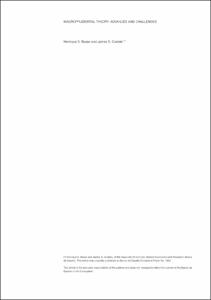Registro completo de metadatos
| Campo DC | Valor |
|---|---|
| dc.contributor.author | Basso, Henrique S. |
| dc.contributor.author | Costain, James |
| dc.date.accessioned | 2020-04-03T07:01:11Z |
| dc.date.available | 2020-04-03T07:01:11Z |
| dc.date.issued | 2016-11 |
| dc.identifier.uri | https://repositorio.bde.es/handle/123456789/11299 |
| dc.description | Artículo de revista |
| dc.description.abstract | This note discusses recent theoretical work analyzing the causes of financial instability, its consequences for the macroeconomy, and thus the potential role for macroprudential policy. After discussing how information asymmetries and strategic complementarities can cause balance sheet losses to propagate through the financial system and over time, we discuss the role of the major classes of macroprudential instruments in preventing instability ex ante and containing it ex post. We conclude with a discussion of current challenges for macroeconomic modeling and for the design of regulation and policy. |
| dc.format.extent | 16 p. |
| dc.language.iso | es |
| dc.relation.ispartof | Revista de Estabilidad Financiera / Banco de España, 31 (noviembre 2016), p. 27-42 |
| dc.rights | Reconocimiento-NoComercial-CompartirIgual 4.0 Internacional (CC BY-NC-SA 4.0) |
| dc.rights | In Copyright - Non Commercial Use Permitted |
| dc.rights.uri | https://creativecommons.org/licenses/by-nc-sa/4.0/deed.es_ES |
| dc.rights.uri | http://rightsstatements.org/vocab/InC-NC/1.0/ |
| dc.title | Macroprudential theory: advances and challenges |
| dc.type | Artículo |
| dc.identifier.bdebib | 000358947 |
| dc.identifier.bdepub | REFI-2016-31-027 |
| dc.subject.bde | Regulación y supervisión de instituciones financieras |
| dc.subject.bde | Política monetaria |
| dc.subject.bde | Teoría monetaría |
| dc.publisher.bde | Madrid : Banco de España, 2016 |












